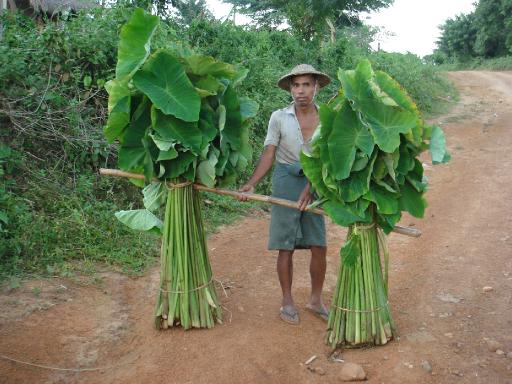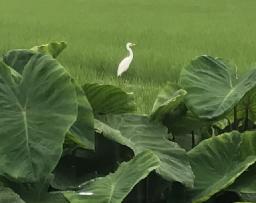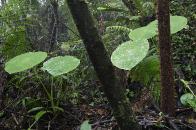
Recently Rated:
Stats
Work interests: Crop Wild Relatives (CWR), plant domestication, crop history, biodiversity, ethnobotany
Affiliation/website: National Museum of Ethnology, Osaka, Japan
Preferred contact method: Any
Preferred contact language(s): English, German
Contact: Dr Peter J. Matthews, Project Leader: pjm [at] minpaku [dot] ac [dot] jp
Favourite publications:
Today I received a link to a new a newly published story in National Geographic magazine.
Title: "How taro is eaten around the world" (11th July, 2023; 7 minute read)
The author, Abigail Bassett (an independent journalist and writer based in California) sent me this note:
"Thanks again for your time a few weeks ago for my story on Taro. The piece is now live on National Geographic, here.
Below: White heron feeding on wildlife in a rice pond next to taro (PJM: Kyoto 13th. July 2023). Taro/rice pondfields in Japan still support some snails, frogs and small fish, though much biodiversity has been lost with the intensive use of herbicides and pesticides. In Southeast Asia, the cultivated wetlands are still a source of many wild foods (including fish and edible wild taros that are cooked and eaten together).

Certain things in the world are considered "food" because we know them as foods. How well we know them is often what determines if they can be harmful or not.
One goal of the modern food industry is to produce cheap uniform foods that are uniformly safe and easy to swallow. As a result (intended or not) consumers know less-and-less about food and become more-and-more dependent on "safe" foods.... which turn out to be harmful when we become massively addicted to simple variations of salt, sugar and fat.
Almost all parts of all varieties of wild and cultivated taro are to some degree poisonous, most obviously because of acridity. But none of these plants are poisonous if we know how to treat them and make them edible. To cook any particular variety of taro well requires accumulated knowledge and experience with that particular variety.
Knowledge and experience are not the same thing. Some cooks learn and use methods faithfully because they are known to work, not because the need for a certain method has been explained. I have met cooks who have experience of preparing taro as a food but don't know that it can be poisonous.
Taro is not a product of the modern food industry.... it remains a food that is largely prepared using very old traditions of culinary knowledge. If and how people in different societies view taro as dangerous or difficult, and why, is largely unknown. Talking to people and asking questions about a danger that most people avoid and have not experienced is not easy.
How do we know what we know about food?
This is an open question for future fieldwork with taro globally.
For a related discussion, see:
https://www.theguardian.com/science/2022/sep/18/are-there-any-foods-that-have-not-at-some-time-been-considered-harmful-in-a-study#comments
(I joined the Guardian Science "Notes & Queries" discussion as "pjm21kyoto"):
Mapping Genetic Diversity in Taro to Test Domestication Theories (2017-2021)
By Research Cooperative, 2022-05-22
The "Mapping Genetic Diversity" was an international research project supported by the Japan Society for the Promotion of Science (JSPS Kakenhi No. 17H04614). Project period: 1st April 2017 - 31st March 2021.
Taro ( Colocasia esculenta ) is an ancient root and vegetable crop of temperate and tropical regions of Africa, Eurasia, and Oceania. In recent centuries it also reached the Americas. We are attempting to learn more about the natural and cultural history of this crop, in Southeast Asia and beyond.
The application for JSPS funding was submitted in October 2016, and accepted in April 2017. These were public funds administered through the National Museum of Ethnology, Japan, under the direction of the project leader, Dr Peter J. Matthews.
See Matthews profile and publications list at the Museum website.
Publications related to this project can be found here: Researchgate profile .
Further publications are planned and will be announced here when published.
Links to related publications by other project members can be added to the Project website, as time permits (e.g. on cultivated taro, or aroid taxonomy). A Wild Taro Working Group will also be developed here.

C. formosana , vic. Mt Polis, Philippines
(PJM, 22nd Nov. 2011)
Until the beginning of 2021, the Wild Taro Research Project was supported by a four-year JSPS grant (1st April 2017- 31st March 2020).
In 2021, Dr Matthews received support from a JSPS project led by Dr Rintaro Ono, and in 2022 he joined a project led by Dr Rintaro Ono at the National Museum of Ethnology, Japan: Maritime Asia and Oceania Studies. This project in turn is supported under the framework of a Networked Core Project for the Promotion of Global Area Studies, directed by the National Institutes for the Humanities (NIHU), Japan.
The funding made available through this collaboration is enough to support a part-time research assistant and analysis of samples collected during previous fieldwork. Our main focus will be a study of genetic diversity in the cultivated aroid Alocasia macrorrhizos and its near relatives (including to some extent Colocasia spp.).
Photo: Alocasia odora in regenerating forest, Ishigaki Island, Japan (PJM, February 2022)
PestNet - Resources and an online community for crop pests and diseases
By Research Cooperative, 2021-08-09
PestNet is a network that helps people worldwide obtain rapid advice and information on crop protection, including the identification and management of plant pests. It started in 1999. Anyone with an interest in plant protection is welcome to join. PestNet is free to members and is moderated, ensuring that messages are confined to plant protection.
The network was initiated in the Pacific Islands and has much useful information on the pests and diseases of taro (Colocasia esculenta).
The taro festivals of Hawaii have been happening for many years.
They are events where local farmers, members of the public, artists, agricultural experts, and many others come together to enjoy the iconic plant of Hawaii, and more than just good food. Taro ("kalo" in the Hawaiian language) has a special status in Hawaii.
The next occasion will be the East Maui Taro Festival on 24th April, 2021. See the details here: https://www.tarofestival.org
Terry Stocker, in an article published online in about 2014, makes some interesting remarks about the role informal street sellers who sell vegetables and other foods on the periphery of commercial markets.
He compares the situation in Mexico and South Korea, and shows photos of "toran" (taro) corms and leaves being sold in Korea.
https://globalethnographic.com/index.php/aspects-of-market-and-culinary-variation/
Many years ago, during a visit to the floating water gardens on Lake Inle in Myanmar, Kyaw Naing and I met a family peeling and drying wild taro petioles for export to Korea. Apparently a Korean visitor had realised that this would be a good product for the Lake residents to export, as the dried petioles of taro are traditionally eaten in Korea.
In the period from April 2019 to March 2020, the project leader (Matthews) visited Bangladesh, India and Thailand for work related to the project.
In collaboration with Dr Md. Anwar Hossain of Bangladesh Agriculture University (BAU), wild taro samples collected by us in 2018 are now being analysed using the same loci studied in other wild populations surveyed in the Philippines, southern China, Taiwan, and Vietnam.
A survey of wild taro populations in and around Bangkok city, in Thailand, was also carried out in collaboration with Dr Duangchai Sookchaloem of Kasetsart University. Leaf samples were collected from across the delta of the Chao Praya river that runs through Bangkok.
Immature fruiting head of Bangkok wild taro, showing abundant small seeds in each berry

